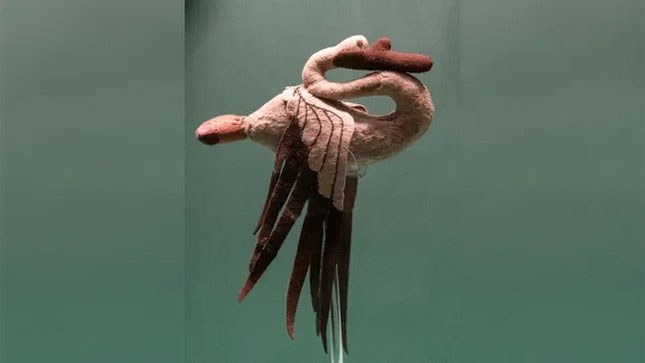The truth about the 2,300-year-old stuffed swan in Siberia
Archaeologists have found a stuffed swan in a burial mound in Siberia. It is believed to belong to the Pazyryk culture , an Iron Age people.
Along with other treasures, the nearly 30cm tall swan was discovered in a burial mound in the Pazyryk Valley in the Altai Mountains, near Russia's borders with Kazakhstan, China and Mongolia.

This stuffed swan from the Siberian Iron Age is made from reindeer wool and represents air, earth and water. (Photo: Dima Moroz).
Archaeologists believe the statue dates back to the fifth or fourth century BC. Its body is made from reindeer wool that has been processed into white felt, while the beak, eyes, and wing tips are made from black felt. Reddish-brown felt was used for the 'feet,' and the body was stuffed with reindeer wool.
The feet contain wooden slats that support the swan in an upright position. Curators at Russia's Hermitage Museum in St. Petersburg, where the statue is on display, believe that these slats were used to place the swan on a wooden chariot found nearby, or possibly on top of a tent-like structure that was erected over the burial mound but has long since decayed.
According to the museum , the swan symbolizes life in three realms: air, land, and water. A swan or similar water bird may also appear in a creation myth. They say there is a common notion of the creation of the universe by a swan, duck, or goose, which is characteristic of many ancient cosmological conceptions.
According to the University of Washington, USA, Soviet archaeologists began excavating ancient burial mounds in the Pazyryk Valley in the 1920s and found the felt swan in 1949. Because the area is high and cold, many burial mounds are always frozen, preserving many organic materials, including human remains.
- Strange swans caught the 'disease' racism?
- Video: Black swan financially surfing
- A pair of swans who ring their bell for food ...
- Unexpected discoveries of swans
- Merciful swan trying to save you from drowning in garbage
- Haunting behind the whimsical white swan nest
- 1,300-year-old mummy in a cocoon of cloth in Siberia
- Swans attacked people on the river
- Monitoring pollution with swan robots in Singapore
- Discovering fossils 'swan dinosaurs' is odd in Mongolia
- Appeared more mysterious craters in Siberia
- The mysterious crater in Siberia houses a 25-storey building
 Discovered an ancient centipede fossil 99 million years old
Discovered an ancient centipede fossil 99 million years old Discovered bat-like dinosaurs in China
Discovered bat-like dinosaurs in China Discovered a 200-year-old bronze cannon of the coast
Discovered a 200-year-old bronze cannon of the coast Discover 305 million-year-old spider fossils
Discover 305 million-year-old spider fossils